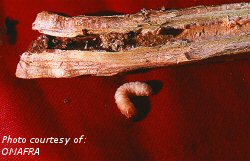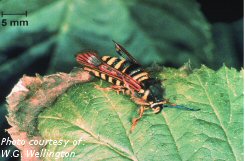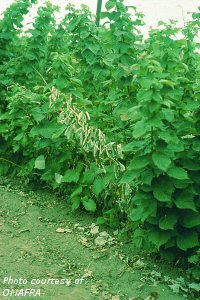Raspberry Crown Borer (Pennisetia Marginata)

Raspberry crown borer larva

Raspberry crown borer adult

Raspberry crown borer damage
Host Plants And Distribution
The raspberry crown borer will attack raspberry, blackberry, loganberry and other native cane fruits. It is found throughout North America.
Biology
The raspberry crown borer adult is a moth that strongly resembles a yellowjacket wasp. Adults are black, with yellow stripes on the abdomen and clear wings. The adults are present in August and September. Eggs are laid on the underside of leaves at this time. After hatching, the larvae migrate to the base of the cane and either excavate a cavity or find a protected place in the bark to overwinter. The following spring, the larvae enter the crown and roots. Larvae usually tunnel into a new cane and girdle it before returning to the roots. At the end of the first year larvae are whitish with a brown head and about 12-18 mm in length. In October, the larvae return to the crown to overwinter in the tunnels. The next spring, larvae continue to bore through the crowns, working their way towards the fruiting canes. Mature larvae reach a length of 30 mm. In July, the mature larvae form pupae and adults emerge again in late summer. The life cycle takes two years to complete but all life stages are present in any given year.
Symptoms And Damage
The symptoms caused by this insect are not easily detected and are often confused with disease symptoms (e.g., cane blight). The first observed symptoms are withering, wilting and dying of the cane foliage, often with half-grown fruit still attached. In the second summer, damaged canes will break off at the damaged area when pulled. Occasionally, swelling in the crown is observed, resulting in death of the entire plant. Injury to the crown is not conspicuous and may be observed only by digging up the crown. Crown damage consists of girdled roots and crowns, and cavities in the exterior of the crowns.
Scouting Techniques
Movement of this moth into a field is gradual and often goes unnoticed. Plants exhibiting wilting and withering of foliage should be closely inspected, especially if nearby plants do not exhibit similar symptoms. Growers may have to dig up the crown to determine whether larvae are present.
Economic Thresholds
Removal of all wild brambles in the vicinity will reduce alternative hosts that may allow unobserved population increases. Pruning, removal and destruction of infested canes and crowns will keep populations down.

